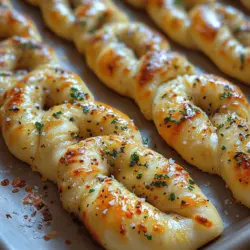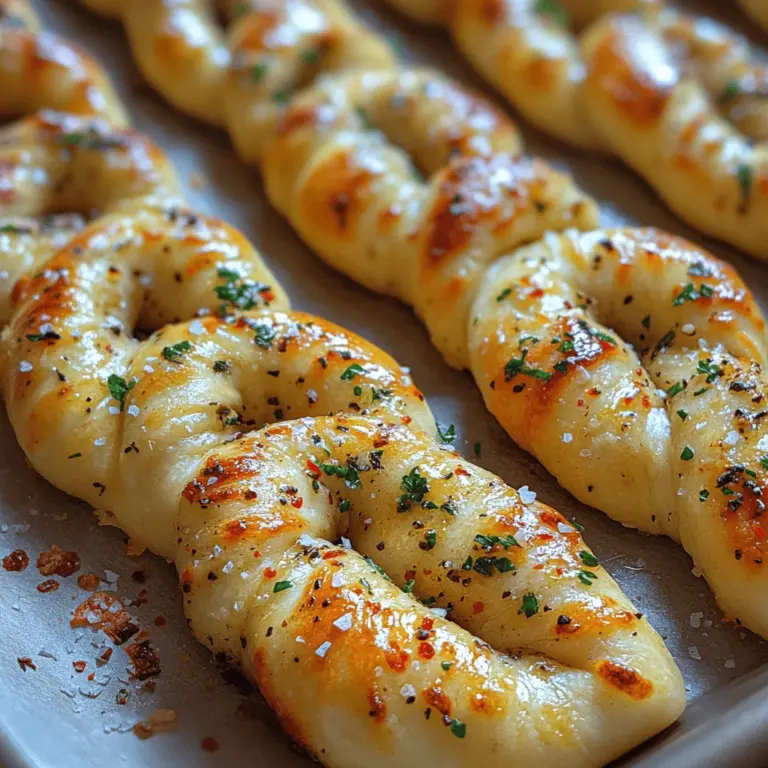Introduction
There’s something undeniably appealing about the aroma of freshly baked bread wafting through your kitchen. Homemade flatbreads, in particular, offer a delightful combination of simplicity and flavor that can elevate any meal or gathering. Among the various types of flatbreads, Garlic Herb Flatbread Twists stand out as a delightful snack or appetizer that is not only easy to make but also incredibly flavorful. Whether you’re hosting a dinner party, enjoying a cozy family meal, or simply looking for a tasty treat, these flatbread twists are sure to impress.
Flatbreads have a unique versatility that makes them a staple in various cuisines worldwide. From Indian naan to Middle Eastern pita and Mediterranean focaccia, flatbreads can be adapted to suit diverse flavors and dining experiences. They serve as an excellent vehicle for dips, spreads, and toppings, making them a favorite among food lovers.
One of the most significant advantages of making flatbreads at home is the health benefits they offer compared to store-bought alternatives. Homemade versions allow for control over the ingredients, enabling you to create a product that is fresher, free from preservatives, and tailored to your dietary preferences. By using wholesome ingredients, you can enjoy a delicious snack that is not only satisfying but also nourishing.
Understanding Flatbreads
Flatbreads, as the name suggests, are unleavened or minimally leavened breads that are rolled flat and baked. Their simplicity and adaptability have made them a beloved staple in many cultures throughout history. Originating thousands of years ago, flatbreads have been a fundamental part of human diets, serving as a versatile food source that can be paired with various dishes.
Historically, flatbreads have played a significant role in numerous global cuisines. In Mediterranean regions, for instance, flatbreads like lavash and pita are often used to scoop up savory dips such as hummus or baba ghanoush. In Middle Eastern cultures, flatbreads are integral to meals, often served with grilled meats and salads. Similarly, Indian cuisine features various flatbreads, such as chapati and naan, which accompany flavorful curries and stews.
The definition of flatbreads encompasses a wide variety of types, each with its own unique texture and flavor profile. Common examples include tortillas, which are essential in Mexican cuisine, and matzah, traditionally eaten during Passover in Jewish culture. Each type of flatbread serves a specific purpose, whether it’s for wrapping, dipping, or simply enjoying on its own.
Key Ingredients and Their Roles
Creating the perfect Garlic Herb Flatbread Twists requires a handful of essential ingredients, each contributing to the overall flavor and texture of the final product. Understanding these ingredients and their roles in the recipe is crucial for successful preparation.
All-Purpose Flour
All-purpose flour is the backbone of the flatbread dough. This versatile flour contains a moderate amount of protein, which helps create a balanced texture that is neither too dense nor too light. When combined with water and yeast, all-purpose flour forms the gluten structure that gives the flatbread its chewy yet tender characteristics.
Active Dry Yeast
Active dry yeast is a key ingredient for providing the lift and airy texture of the flatbread twists. It acts as a leavening agent, fermenting the sugars in the dough and producing carbon dioxide, which causes the dough to rise. For optimal results, it’s essential to activate the yeast correctly by dissolving it in warm water, allowing it to become bubbly and frothy before mixing it into the dough.
Olive Oil
Olive oil is not just an ingredient for flavor; it also plays a crucial role in the dough’s moisture content. By incorporating olive oil, you enhance the richness of the flatbread and create a soft, tender crumb. Additionally, the healthy fats in olive oil contribute to the overall nutritional profile of the flatbread, making it a heart-healthy choice.
Garlic and Herbs
The garlic and herbs are what give the flatbread its signature flavor. Freshly minced garlic infuses the dough with aromatic notes that complement the earthy undertones of the flour. Meanwhile, a medley of herbs—such as rosemary, thyme, or oregano—adds depth and complexity to each bite. These ingredients can be adjusted to suit personal tastes, allowing for a delightful customization of the flatbread’s flavor profile.
Optional Ingredients
While the core recipe is delicious on its own, you might consider adding optional ingredients such as red pepper flakes for a hint of heat or grated cheese for an extra layer of richness. These additions can enhance the flavor experience, making the Garlic Herb Flatbread Twists even more enticing.
Step-by-Step Preparation of Garlic Herb Flatbread Twists
Now that we have a thorough understanding of the ingredients, let’s dive into the detailed preparation of Garlic Herb Flatbread Twists. Follow these step-by-step instructions for a successful result:
Activating the Yeast
The first step in making Garlic Herb Flatbread Twists is to activate the yeast. This step is critical for ensuring that your dough rises properly and develops a light, airy texture. Begin by measuring out the warm water (around 105°F to 110°F) and pouring it into a bowl. Add the active dry yeast and a teaspoon of sugar to the water. The sugar serves as food for the yeast, helping it to activate more quickly. Stir gently to combine, then let the mixture sit for about 5 to 10 minutes. You’ll know the yeast is activated when it becomes frothy and bubbly, indicating that it’s ready to be incorporated into the dough.
Making the Dough
With your yeast activated, it’s time to make the dough. In a large mixing bowl, combine the all-purpose flour and salt. Create a well in the center of the flour mixture, then pour in the activated yeast mixture and olive oil. Using a wooden spoon or your hands, mix the ingredients together until they form a shaggy dough. At this stage, you may need to adjust the consistency by adding a little more flour or water. The goal is to achieve a dough that is moist but not sticky.
Kneading Techniques
Once your dough has come together, it’s time to knead it. Turn the dough out onto a lightly floured surface and begin to knead it by pressing it down with the heel of your hand, folding it over, and repeating the process. This action helps to develop the gluten, which is essential for a chewy texture. Knead the dough for about 8 to 10 minutes, or until it becomes smooth and elastic. If the dough sticks to your hands, you can sprinkle a little more flour as needed.
As you knead, pay attention to the dough’s texture. It should be pliable and spring back when pressed gently. Once you’ve achieved the desired consistency, shape the dough into a ball and place it in a lightly oiled bowl. Cover the bowl with a clean kitchen towel or plastic wrap and let it rise in a warm, draft-free area for about 1 hour, or until it has doubled in size.
This preparation stage sets the foundation for your Garlic Herb Flatbread Twists, ensuring that you create a delicious and satisfying snack that everyone will love. As you move on to the next steps, you’ll discover how to shape and bake these delightful twists, resulting in a mouthwatering addition to any meal or gathering. Stay tuned for the continuation of this recipe, where we’ll explore the final steps to achieving the perfect Garlic Herb Flatbread Twists.

The First Rise: Factors Affecting Dough Rising and Ideal Conditions
The first rise is a crucial step in the baking process, serving as the foundation for the texture and flavor of your Garlic Herb Flatbread Twists. Many factors can influence how well your dough rises, including temperature, humidity, and the type of flour you use. Ideally, you want to create an environment that is warm and draft-free for optimum yeast activity.
A temperature range of 75°F to 80°F (24°C to 27°C) is generally ideal for yeast to thrive. If your kitchen is cool, consider placing the dough in an unheated oven with the light on or near a warm appliance. Additionally, using fresh yeast is essential, as expired or improperly stored yeast can lead to insufficient rising. If you’re unsure about your yeast’s potency, a simple test is to dissolve it in warm water with a bit of sugar; if it bubbles within 10 minutes, it’s active and ready for use.
Preparing the Garlic Herb Mixture: Best Practices for Maximizing Flavor
A well-prepared garlic herb mixture can elevate your flatbread twists to new heights. Start with fresh herbs like parsley, basil, or oregano, as they impart a vibrant flavor. Mince the herbs finely to maximize their aroma and taste when mixed with the olive oil.
For the garlic, fresh cloves are always preferable to pre-minced garlic. Mincing the garlic finely ensures it distributes evenly throughout the mixture. Combine the minced garlic with olive oil in a small bowl, adding a pinch of sea salt to enhance the flavors. Allow the mixture to sit for a few minutes before spreading it on the dough; this allows the garlic to infuse the oil, creating a more aromatic and flavorful base for your flatbreads.
Creating the Twists
Techniques for Rolling Out the Dough: Achieving the Perfect Rectangle Size
Once your dough has risen to approximately double its size, it’s time to roll it out. Flour your work surface generously to prevent sticking. Using a rolling pin, flatten the dough into a rectangle that is about 1/4 inch (0.6 cm) thick. Aim for a size of approximately 12 inches by 16 inches (30 cm by 40 cm) for even twists.
If the dough resists rolling, let it rest for a few minutes. This allows the gluten to relax, making it easier to shape. Make sure to maintain an even thickness to ensure uniform baking.
Spreading the Herb Mixture: Tips for Even Coverage
With the dough rolled out, it’s time to spread the garlic herb mixture. Use a spatula or the back of a spoon to apply the mixture evenly across the surface of the dough, leaving a small border around the edges. This prevents the filling from spilling out when twisting.
To ensure every bite is flavorful, consider reserving a small amount of the mixture for brushing on top after baking. This extra layer of flavor can make a significant difference in taste and appearance.
Cutting and Twisting: Visual Descriptions or Imagery for Clarity
Now comes the fun part—cutting and twisting the dough. Using a sharp knife or pizza cutter, slice the dough into strips about 1 inch (2.5 cm) wide. For a more rustic look, you can vary the widths slightly.
To create the twists, take each strip and hold both ends, gently twisting them in opposite directions. The twisting motion not only looks appealing but also helps to incorporate air into the bread, resulting in a lighter texture. Place the twisted strips on a parchment-lined baking sheet, leaving space between them to allow for the second rise.
Baking the Flatbread Twists
Importance of the Second Rise: How It Affects the Final Product
After shaping, the dough requires a second rise, which is just as important as the first. This rise allows the gluten to relax and the yeast to produce carbon dioxide, creating air pockets that give your flatbreads their light and fluffy texture. Allow the twisted flatbreads to rise for about 30 minutes in a warm, draft-free location until they puff up slightly.
Preheating the Oven: Why This Step Cannot Be Overlooked
While the dough is rising, preheat your oven to 400°F (200°C). Preheating is essential for achieving that perfect golden-brown crust. If you place the dough in an unheated oven, it can lead to uneven baking and a dense texture.
Baking Tips: Signs of Doneness and How to Achieve the Ideal Golden Brown Finish
Bake the flatbread twists for about 15-20 minutes or until they are golden brown. Keep an eye on them, as oven temperatures can vary. The flatbreads are done when they are golden on top and sound hollow when tapped on the bottom. If you reserved some garlic herb mixture, brush it on top of the twists as soon as they come out of the oven for an added burst of flavor.
Serving Suggestions
Presentation Ideas for Garlic Herb Flatbread Twists
Presentation is key to making your Garlic Herb Flatbread Twists even more appealing. Serve them in a rustic wooden bowl or on a wooden board for a touch of charm. You can also garnish the twists with additional fresh herbs or a sprinkle of sea salt for a pop of color and flavor.
Pairing Options: Dips, Sauces, or Beverages that Complement the Flatbreads
These flatbreads are incredibly versatile and can be served with a variety of dips and sauces. Consider pairing them with a classic marinara sauce, tzatziki, or a spicy hummus. For a more indulgent option, serve with a warm cheese dip or garlic butter sauce.
When it comes to beverages, a light white wine or a refreshing herbal iced tea pairs beautifully with the herby flavors of the flatbreads, making them an excellent addition to any gathering.
Variations on the Recipe: Adding Cheese, Different Herbs, or Toppings
Feel free to get creative with your flatbread twists! You can add shredded cheese—like mozzarella or parmesan—into the herb mixture for a cheesy twist. Experiment with different herbs like thyme, rosemary, or even a bit of crushed red pepper for a spicy kick.
For a gourmet touch, consider adding toppings like sun-dried tomatoes or olives before twisting. The possibilities are endless, allowing you to customize the recipe to fit your taste preferences.
Health Benefits of Homemade Flatbreads
Comparison of Homemade Versus Store-Bought Flatbreads
One of the significant advantages of making your flatbreads at home is the ability to control the ingredients. Store-bought flatbreads can often contain preservatives and additives, while homemade versions allow for a clean label with no hidden ingredients.
Nutritional Advantages of Controlling Ingredients
By preparing your flatbreads, you can incorporate whole grains or alternative flours, making them healthier. You can use whole wheat flour or gluten-free flour blends, depending on dietary preferences. This control over ingredients ensures that you’re serving a delicious product that aligns with your nutritional goals.
Customization Options for Dietary Needs
If you have dietary restrictions or preferences, homemade flatbreads offer a world of customization. You can easily make gluten-free versions by substituting all-purpose flour with gluten-free flour blends. Additionally, for a vegan option, simply replace butter with olive oil and ensure that any cheese additions are plant-based.
Conclusion
Making Garlic Herb Flatbread Twists at home is a simple and rewarding process that yields delicious results. With just a few ingredients and some attention to detail, you can create a delightful snack or appetizer that will impress family and friends.
Embrace the versatility of this recipe by experimenting with different flavors, ingredients, and serving styles. The joy of cooking and sharing homemade food with loved ones is truly unparalleled. So, gather your ingredients, roll up your sleeves, and enjoy the satisfaction of creating something special from scratch. Your kitchen will soon be filled with the irresistible aroma of freshly baked flatbreads, inviting everyone to gather around the table for a taste of your culinary creation.


